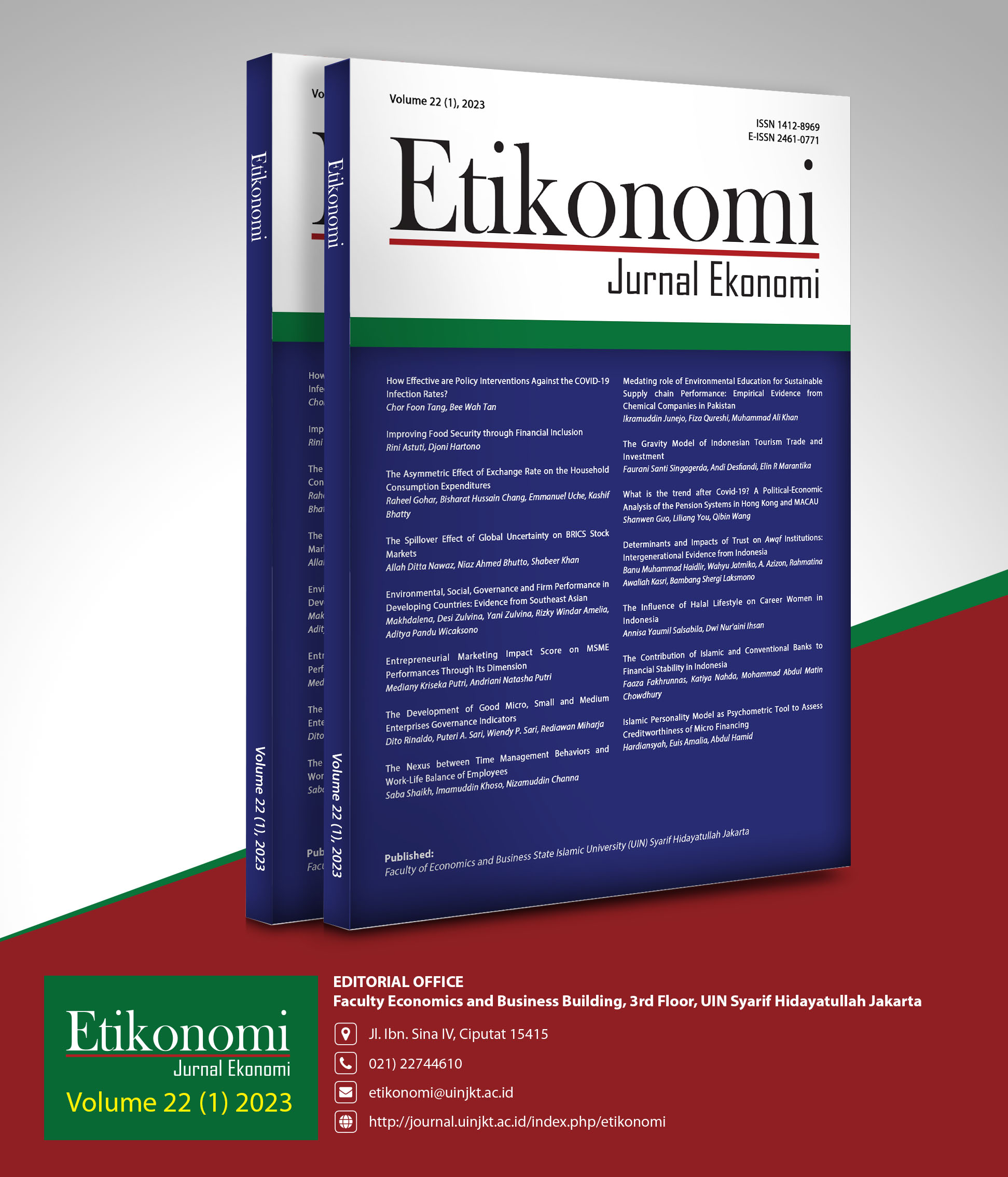How Effective are Policy Interventions Against the COVID-19 Infection Rates?
DOI:
https://doi.org/10.15408/etk.v22i1.28486Keywords:
covid-19, infection rates, permanent shock, transitory shock, unit rootAbstract
Studies on the COVID-19 pandemic are more likely to concentrate on the effects of the virus while ignoring its time-series characteristics, particularly its stationarity characteristics. Thus, this study attempts to investigate the effectiveness of policy interventions against COVID-19 by determining the permanent or transitory effects in 5 major regions and the ten most infected countries. Using the endogenous multiple breaks unit root tests introduced by Kapetanios (2005), the findings indicate that only the impacts of shocks to COVID-19 infection rates in France are likely to be permanent. However, the transitory effect is found in Brazil, Germany, Iran, Italy, Russia, Spain, Turkey, the United Kingdom, and the United States. The country where the shock has a permanent impact is suitable for policy interventions, including lockdowns, social isolation, and local isolation. While herd immunity, which protects the entire population against COVID-19, is better ideal for application in countries that experience shocks with a transitory effect.
JEL Classification: C1, I15, I18
How to Cite:
Tang, C.F., & Tan, B.W. (2023). How Effective are Policy Interventions Against the COVID-19 Infection Rates? Etikonomi, 22(1), 1–14. https://doi.org/10.15408/etk.v22i1.28486.
Downloads
References
Al-Malkey, M. K. & Al-Sammak, M. A. (2020). Incidence of the COVID-19 in Iraq: Implications for Travellers. Travel Medicine and Infectious Disease, 38, 101739.
Bayyurt, L. & Bayyurt, B. (2020). Forecasting of COVID-19 Cases and Deaths using ARIMA Models. medRxiv, https://doi.org/10.1101/2020.04.17.20069237
Bai, J. & Perron, P. (1998). Estimating and Testing Linear Models with Multiple Structural Changes. Econometrica, 66(1), 47-78.
Buonsenso, D., Sali, M., Pata, D., De Rose, C., Sanguinetti, M., Velentini, P., & Delogu, G. (2020). Children and COVID-19: Microbiological and Immunological Insights. Pediatric Pulmonology, 55(10), 2547-2555.
Chang, T. Y. & Nieh, C. C. (2004). A note on testing the causal link between construction activity and economic growth in Taiwan. Journal of Asian Economics, 15(2), 591-598.
Chagla, Z. & Pai, M. (2021). COVID-19 boosters in rich nations will delay vaccines for all. Nature Medicine, 27, 1659-1660.
Cui, J., Li, F. & Shi, Z.L. (2019). Origin and evolution of pathogenic coronaviruses. Nature Reviews Microbilogy, 17, 181-192.
Desson, Z., Weller, E., McMeekin, P., & Ammi, M. (2020). An analysis of the policy responses to the COVID-19 pandemic in France, Belgium, and Canada. Health Policy and Technology, 9(4), 430-446.
Giovanetti, M., Benvenuto, D. Angeletti, S., & Ciccozzi, M. (2020). The first two cases of 2019-nCoV in Italy: Where they come from? Journal of Medical Virology, 92(5), 518-521.
Goodell, J. W. (2020). COVID-19 and finance: Agendas for future research. Finance Research Letters, 35, 101512.
Harrington, W. N., Kackos, C. M., & Webby, R. J. (2021). The evolution and future of influenza pandemic preparedness. Experimental Molecular Medicine, 53, 737-749.
Honey-Rosés, J., Anguelovski, I., Chireh, V. K., Daher, C., van den Bosch, C. K., & Litt, J. S. (2020). The impact of COVID-19 on public space: An early review of the emerging questions – Design, perceptions and inequities. Cities & Health, 5(1), 263-279.
Kapetanios, G. (2005). Unit-root testing against the alternative hypothesis of up to m structural breaks. Journal of Time Series Analysis, 26(1), 123-133.
Lai, C. C., Shih, T. P., Ko, W. C., Tang, H. J., & Hsueh, P. R. (2020a). Severe acute respiratory syndrome coronavirus 2 (SARS-CoV-2) and coronavirus disease-2019 (COVID-19): The epidemic and the challenge. International Journal of Antimicrobial Agents, 55(3), 1-9.
Lai, C. C., Wang, C. Y., Wang, Y. H, Hsueh, S. C., Ko, W. C., & Hsueh, P. R. (2020b). Global epidemiology of coronavirus disease 2019 (COVID-2019): Disease incidence, daily cumulative index, mortality, and their association with country healthcare resources and economic status. International Journal of Antimicrobial Agents, 55, 1-8.
Liao, Z. X., Campo, E. R. L., Salem, A., Pang, Q. S., Liu, H., & Guerra, J. L. L. (2020). Optimizing lung cancer radiation treatment worldwide in COVID-19 outbreak. Lung Cancer, 146, 230-235.
Lumsdaine, R. L. & Papell, D. H. (1997). Multiple trend breaks and the unit-root hypothesis. Review of Economics and Statistics, 79(2), 212-218.
Mamun, M. A. & Ullah, I. (2020). COVID-19 suicides in Pakistan, dying off not COVID-19 fear but poverty? The forthcoming economic challenges for developing country. Brain, Behavior, and Immunity, 87, 163-166.
Mathieu, E., Ritchie, H., Ortiz-Ospina, E., Roser, M., Hasell, J., Appel, C., Giattino, C., & Rodés-Guirao, L. (2021). A global database of COVID-19 vaccinations. Nature Human Behaviour, 5, 947-953.
Murthi, M. & Reed, T. (2021). Policy Actions to Increase the Supply of COVID-19 Vaccines in the Short Term. Research & Policy Brief, No. 40 Washington, D.C.: World Bank Group. Available at: http://documents.worldbank.org/curated/en/468901628844279416/Policy-Actions-to-Increase-the-Supply-of-COVID-19-Vaccines-in-the-Short-Term
Narayan, P. K. (2005). The relationship between saving and investment for Japan. Japan and the World Economy, 17(3), 293-309.
Narayan, P. K. & Popp, S. (2010). A new unit root test with two structural breaks in level and slope at unknown time. Journal of Applied Statistics, 37(9), 1425-1428.
Nicola, M., Alsafi, Z., Sohrabi, C., Kerwan, A., Al-Jabir, A., Losifidis, C., Agha, M., & Agha, R. (2020). The socio-economic implications of the coronavirus pandemic (COVID-19): A review. International Journal of Surgery, 78, 185-193.
OECD (2020). Testing for COVID-19: A Way to Lift Confinement Restrictions. Secretary-General of the OECD, 4 May, Available at: http://www.oecd.org/coronavirus/policy-responses/testing-for-covid-19-a-way-to-lift-confinement-restrictions-89756248/#boxsection-d1e31 (Accessed: 27 May 2020).
Plümper, T. & Neumayer, E. (2020). Lockdown policies and the dynamics of the first wave of the Sars-CoV-2 pandemic in Europe. Journal of European Public Policy, 29(3), 321-341.
Randolph, H. E. & Barreiro, L. B. (2020). Herd immunity: Understanding COVID-10. Immunity, 52(5), 737-741.
Rath, B. N. & Akram, V. (2021). Popularity of unit root tests: A review. Asian Economics Letters, 2(4), 1-4.
Rowe, F., Ngwenyama, O., & Richet, J. L. (2020). Contact-tracing apps and alienation in the age of COVID-19. Eruopean Journal of Information System, 29(5), 545-562.
Rusell, T. W., Wu, J. T., Clifford, S., Edmunds, W. J., Kucharski, A. J., & Jit, M. (2021). Effect of internationally imported cases on internal spread of COVID-19: A mathematical modelling study. The Lancet Public Health, 6(1), e12-e20.
Sen, A. (2003). On unit-root tests when the alternative is a trend break stationary process. Journal of Business and Economic Statistics, 21(1), 174-184.
Sharif, A., Aloui, C., & Yarovaya, L. (2020). COVID-19 pandemic, oil prices, stock market, geopolitical risk and policy uncertainty nexus in the US economy: Fresh evidence from the wavelet-based approach. International Review of Financial Analysis, 70, 101496.
Stehlík, M., Kiselák, J., Dinmarca, M. A., Li, Y., & Ying, Y. (2020). On COVID-19 outbreaks predictions: Issues on stability, parameter sensitivity, and precision. Stochastic Analysis and Application, 39(3), 383-404.
WHO (2020). Laboratory testing for coronavirus disease 2019 (COVID-19) in suspected human cases: Interim Guidance. World Health Organization, 2 March, Available at: https://apps.who.int/iris/handle/10665/331329 (Accessed: 21 May 2020).
World Tourism Organisation (2019). International Tourism Highlights, 2019 Edition. UNWTO, Madrid.
Yezli, S. & Khan, A. (2020). COVID-19 Social Distancing in the Kingdom of Saudi Arabia: Bold Measures in the Face of Political, Economic, Social and Religious Challenges. Travel Medicine and Infectious Disease, 37, 101692.
Zivot, E. & Andrews, D. W. K. (1992). Further Evidence of the Great Crash, the Oil-Price Shock and the Unit-root Hypothesis. Journal of Business and Economic Statistics, 10(3), 251-270.










